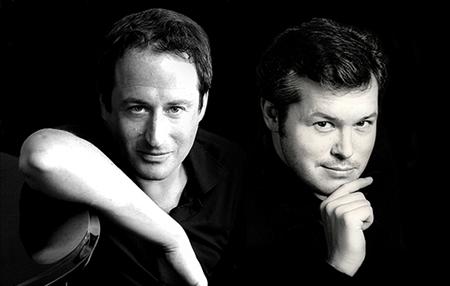Repin and Golan prove equal partners with evening of inspired music-making

Vadim Repin (right) and Itamar Golan performed Sunday night at Jordan Hall.
Russian violinist Vadim Repin and his keyboard counterpart, Itamar Golan, turned out a substantial program Sunday evening at Jordan Hall, a presentation of Maestro Artist Management.
Repin has the name, and it was his reputation that filled the hall with a largely Russian audience, which was clearly aware of his prodigious showmanship. But he was matched onstage by the intense and talented Golan. The repertory—sonatas by Janáček, Ravel and Grieg, Chausson’s Poème, Op. 25, and the Ravel Tzigane—largely focused on music-making, and not violin pyrotechnics—added to the collaborative feeling.
Janáček’s Sonata for Violin and Piano, written in 1914, mirrors the turmoil the composer was experiencing in his war-torn homeland. Beautiful melodies appear wistfully, then disappear in a cacophony of crashing chords and slurred phrases. In the first movement, marked Con moto, Repin and Golan were in two separate musical worlds. Golan, seemingly the more astute chamber musician, appeared more comfortable. Repin played like a concerto artist: some pizzicato accents were off the beat, as if he were waiting for an orchestra to catch up with him. An alluring melody up the scale in the violin in the fourth movement characterized the turbulent work. Repin carved it gracefully out of nowhere; just as quickly, it vanished, with an arpeggiated figure of intensity from the pianist.
Ravel’s Violin Sonata in G Major suited the players better. The work is a blues, with the unusual progression from G major to B-flat then to F-natural, but not in an orderly fashion. Pitches alter from the violin to the piano left hand, then to the right hand, in an sequence that creates the feel of the blues, but with the tension of atonality. Here, especially in the Moderato second movement, Repin showed his stuff, as slurring accents transformed quickly into martelé passages to accent the staccato interludes. In the third movement Perpetuum mobile, Repin sketched out a sax-like line that Golan could interact with, particularly in the right hand, with chords that retraced earlier ideas. Interaction was intense, and carefully executed.
The Grieg Sonata, Opus 13, no. 2, also in G major, has its own roots origins, but in Nordic folk material, not American blues. Repin played this and the entire second half of the program from memory, and seemed more at ease. A Lento opening gives this sonata an introspective feel: Repin, standing stock-still on the stage, delivered it with a sure tone. He has all the fingering techniques of great violinists, but it’s his bowing that sets him apart: consistent and confident, with even tension maintained from frog to tip. For this sonata, that created a firm baseline for Golan to introduce the contrapuntal material, some piano, some with almost overwhelming forte.
Chausson’s Poème, Opus 25, perhaps his greatest work, was written for orchestra, but its piano reduction loses little in translation. It is built around the violinist’s sweeping melodic fantasies, but Golan’s capturing of orchestral colors—pedaled expertly, and showing a prodigious left-hand—brought it to life. With Ravel’s Tzigane, it was Repin’s turn to shape the music, capping the evening with a display of double pizzicato showmanship.
Posted in Performances